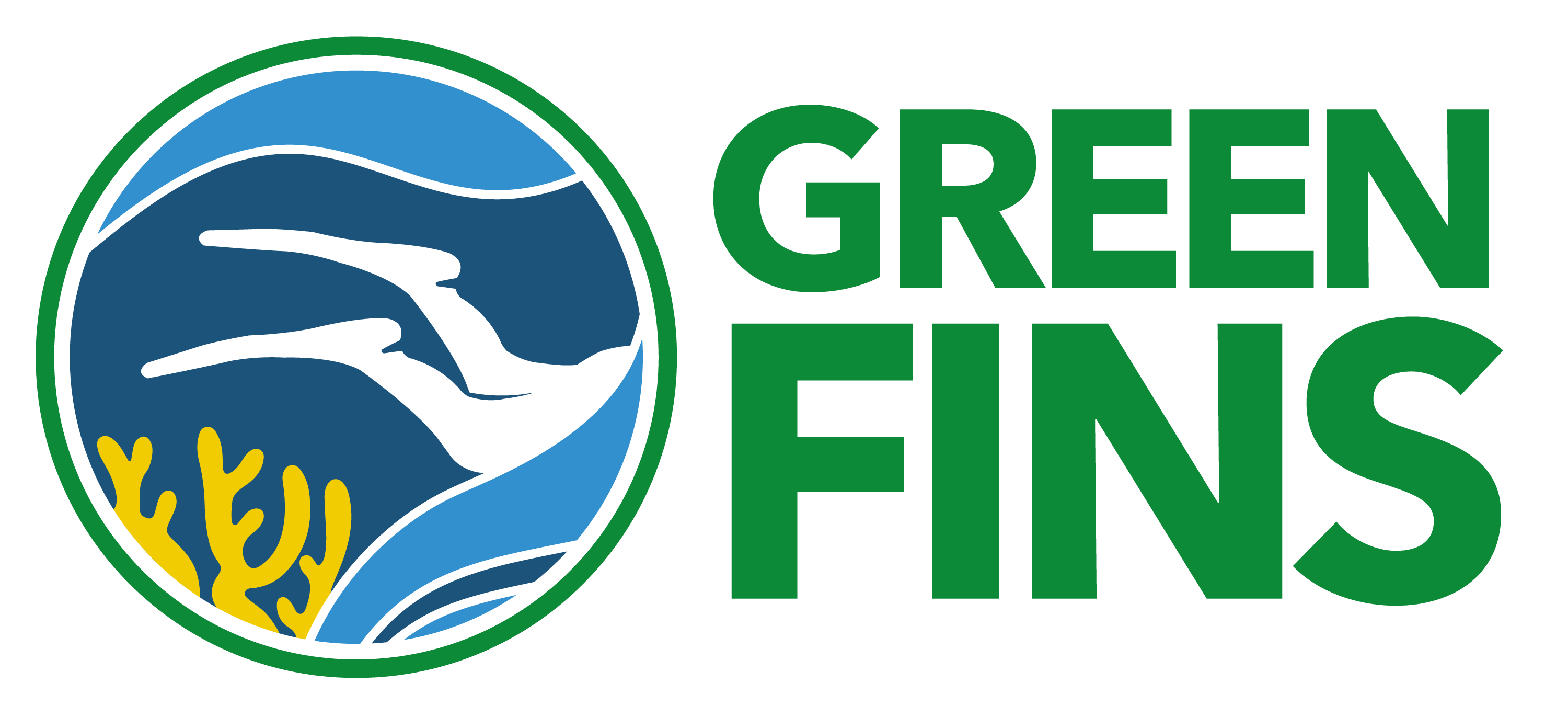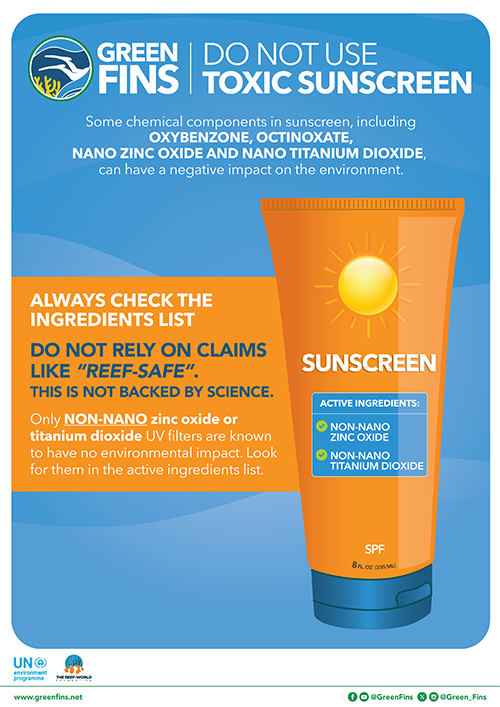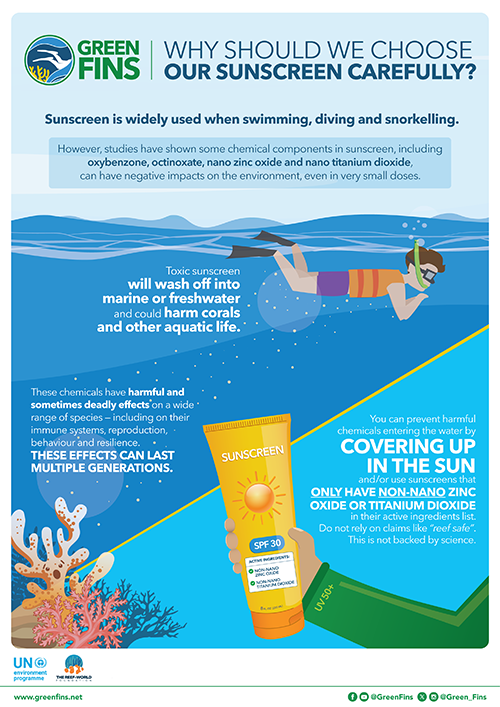Picture this: you’ve just emerged from an invigorating early morning dive, greeted by the warmth of the sun on your face and the shimmering waters around you. Awaiting you on the boat is a steaming cup of coffee, and with the holiday tan calling, you decide to apply some reef-safe sunscreen. After all, who wants to deal with the discomfort of neoprene on sunburn? You’re not alone — so many of us, including the Reef-World team, prioritise packing reef-safe sunscreen before venturing into the water.
Just one issue: there is no such thing as “reef safe” 😱😱
The history of sunscreen
The history of sun protection is likely as old as humanity itself. Ancient Greeks used olive oil to protect the skin from sun damage, ancient Egyptians used rice, jasmine and lupine plants; indigenous people of the Sulu Sea, Myanmar and Madagascar have used variations of leaf, bark or zinc oxide pastes for thousands of years. It wasn’t until 1928 that the first ultraviolet B filters were produced in Australia. In 1936 L’Oreal produced its first sunscreen product, and during World War II, the US military popularised sunscreens for its troops in the Pacific.
Since then, sunscreen development has led to water-resistant sunscreens and broad-spectrum protection (blocked UVA and UVB rays) to better protect our skin. In 2023, there are two main types of sunscreen:
1. Organic UV filters
In the context of sunscreen chemistry, the term ‘organic’ in chemistry refers to compounds containing carbon. It does not mean biodegradable or non-toxic. Many of these UV filters are petrochemical-based. They work by absorbing UV light. Oxybenzone and octinoxate are examples of organic compounds.
2. Inorganic UV filters
This refers to mineral UV filters like zinc oxide or titanium dioxide that work by reflecting, scattering or absorbing UV light. There are different sizes of these compounds, which in turn interact with the environment differently. Smaller compounds are more readily absorbed by marine life.
In 2003, the first study showing the environmental impacts of sunscreen on the marine environment was published: sunscreen products alter the microbiome and promote virus growth1. In 2008, a follow-up study showed that “sunscreens cause the rapid and complete bleaching of hard corals, even at extremely low concentrations.”2 These studies represented the first steps into what would turn out to be the extremely complicated field of ecotoxicological research into UV filters.
Sunscreen bans to protect reefs
In 2018, Palau’s announcement of an upcoming ban on sunscreens containing harmful UV filters sparked a global conversation about the impact of these chemicals on reefs. The International Coral Reef Initiative (ICRI) reinforced this stance the following year, urging the development of environmentally friendly sunscreen without notorious culprits like oxybenzone and octinoxate as well as the development of regulations and policies around its production and sale. As more countries and states announced their own bans, the market responded (before the regulatory bodies), and a surge of “reef-safe” products and new UV filters flooded the market.
We at Reef-World dove into the research papers and found that the science was ‘young’ but the potential impacts of certain UV filters were severe enough to warrant a precautionary approach for coral reefs and ecosystems already suffering from global threats. Through Green Fins, we jumped on the ‘reef safe’ bandwagon. Clearly, it wasn’t a label, but at least it served as a clear guide for tourists to see what products to buy and what to avoid. We included sunscreen with harmful UV filters as a pollutant in the Green Fins assessment criteria for Green Fins members, and created two sunscreen educational materials.

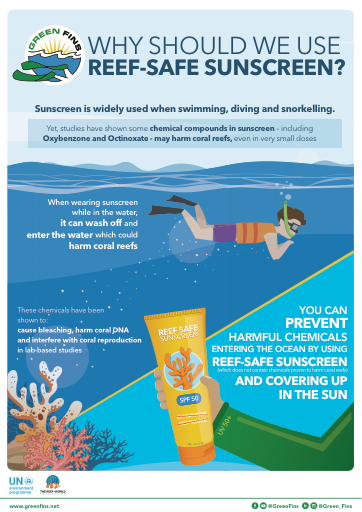
But as time flowed on, the term “reef safe” multiplied into confusing variations: reef-friendly, ocean-friendly, coral-safe, marine-friendly, sustainable sunscreen and biodegradable, to name a few. Unfortunately, there is no unified definition of what “reef safe” actually means. There are no regulatory bodies (e.g. FDA, REACH) that test for this label. There are no globally accepted scientific definitions of the term.
“Reef safe” and all its permutations are only marketing terms.
One of the biggest reasons for this is there are few, if any, standardised toxicological methodologies for marine life, let alone coral.
Sunscreen Science
Ecotoxicological tests are conducted in laboratory conditions in order to be able to accurately isolate the compounds and mechanisms through which toxins affect species. Marine species are harder to keep alive in a lab, and the huge variation in the ocean environment (think mineral content, light conditions, salinity, pH) means conducting these tests in the ocean are pretty much impossible. Because of this, sunscreen ecotoxicological science is still in its infancy.
Marine biologists have been trying to fill this gap in knowledge using different methods and looking for different levels of toxicity (e.g. lethal vs sublethal, at the organism or cellular level). So whilst we are starting to understand the ecological impact of sunscreen, there is no singular story of sunscreen to tell, and there are still a lot of questions that need answering.
At Reef-World, we strive to empower people with environmental solutions based on the best available science, even if it’s as complicated as sunscreen. We recognise that science is a process – a conclusion may be reached with the knowledge and research at the time and be updated or revised years later when more information comes to light. This is science working as it should.
In 2023, we conducted another literature review of sunscreen research, checked in with toxicologists and reef-safe sunscreen companies and here are some of our big takeaways:
- UV filters have been found across the oceans, including the arctic3
- The toxicity of some UV filters can increase when exposed to different environmental conditions (e.g. sunlight, salinity and pH)4, 8
- UV filters can bioaccumulate in life at all levels of the food web, from the microbiome to coral tissue, to seafood species and marine mammals5, 7, 15, 16, 21, 23
- The bioaccumulation of UV filters in sediments and fatty tissue may hide the true amount of these compounds in the environment 7,23
- UV filters can cause sublethal impacts that damage an organism5, 6, 15, 18, 20, 22
- Damage caused by UV filters can be passed down through multiple generations of invertebrate6
- Different species can have different sensitivities to sunscreen compounds4
- Nano zinc oxide is potentially more harmful to coral than oxybenzone10, 14, 17, 19
- Removing one harmful UV filter doesn’t make a product non-toxic4, 8, 9
- The perfume, emulsifying and thickening agents and combining agents, also used in sunscreen, can be toxic themselves or combine with other ingredients / react to environmental conditions and become compounds toxic to marine life. The whole sunscreen product needs to be tested, not just the UV filters8, 9,
- Sunscreen dissolved in seawater can fuel algal growth11
- Sunscreens with a spray application pose the most risk as the ingredients have been made more soluble11
- Landlocked sunscreen use still impacts the ocean through our urine and wastewater treatment plant effluent12
- Marine life that is already bleached is at enhanced risk to oxybenzone toxicity13

So, is sunscreen a major threat to coral reefs?
Climate change is THE overarching threat to reefs, and conservation efforts have diverged into two prongs: global initiatives dealing with emissions, sequestration and policy, and localised strategies to combat immediate environmental hazards. This enables ecosystems to be more resilient to weather changes in climate and remain functional.
Whilst we don’t know the full story of sunscreen toxicity, the potential impacts are just one of the many local threats that need to be tackled in order to enable reef resilience in a changing climate.
It is vitally important that steps to tackle sunscreen pollution – be it a national ban, a tourism operator policy or an individual consumer choice – are recognised as one tool in the toolbox of environmental protection. It may be a quick win, but avoiding sunscreen alone will not save reefs from bleaching.
Do UV filters affect other environments too?
Yes, absolutely. UV filter compounds have been shown to affect freshwater species as well as invertebrates that live in temperate waters24 as well as tropical. Tourists diving into freshwater and coldwater environments need to be equally wary of their sunscreen use.
The new Green Fins sunscreen posters
In response to the recent science, we have updated the messaging of the Green Fins sunscreen posters with the core message to only buy sunscreens that only use NON-NANO zinc or titanium dioxide as UV filters.
What can tourists do?
Due to the nature of standardised toxicological testing, it is unlikely that any regulatory frameworks will be developed to define ‘reef safe’ and guide the cosmetic industry in the immediate future. So it’s up to us to do our due diligence. Here are some steps you can take today:
1. MINIMISE YOUR NEED FOR SUNSCREEN AROUND THE OCEAN
- Consider covering up with UPF or light clothes instead of sunscreen if you can.
- Stay in the shade during peak sun hours (10am – 3pm)
- Avoid spray or misting sunscreen products
2. CHOOSE SUNSCREENS THAT ONLY HAVE NON-NANO ZINC OXIDE OR NON-NANO TITANIUM DIOXIDE UV FILTERS
It’s imperative to check the ingredients list of your sunscreens and NOT BUY any that contain:
- ❌ Oxybenzone
- ❌ Octinoxate
- ❌ 4-methylbenzylidene camphor
- ❌ Octocrylene
- ❌ Para-aminobenzoic acid (PABA)
- ❌ Methyl Paraben
- ❌ Ethyl Paraben
- ❌ Propylparaben
- ❌ Butyl Paraben
- ❌ Benzyl Paraben
- ❌ Triclosan
- ❌ Homosalate
- ❌ Octisalate
- ❌ Butyloctyl salicylic acid
- ❌ Propylparaben
- ❌ Any form of microplastic sphere or beads.
- ❌ Any nanoparticles like zinc oxide or titanium dioxide.
⚠️ Note that applying toxic sunscreen for any amount of time in advance of entering the water makes no difference to its impact on the environment.
🪸 We found one organisation with a robust testing process for certifying sunscreens without any of the chemicals listed above – we like that they test the whole product and at several points throughout the product life, including on the shelves and that the results are publicly available. Check out The Protect Land + Sea Certification (PL+S) by the Haeretics Environmental Laboratory (HEL) for more information. They also maintain an up-to-date list of known toxic sunscreen ingredients.
3. DIVE OR SNORKEL WITH A GREEN FINS MEMBER
Support operators that are working to reduce all their local impacts on the marine environment so our tourism sites stay more resilient to climate change. See the list of active members here.
4. REDUCE EMISSIONS WHERE YOU CAN
Using non-nano mineral sunscreen is a great tangible choice you can make, but it won’t balance your net impact on the oceans if you’ve flown across the world to use it!
How can marine tourism operators help?
- Make sure guests know to only use non-nano zinc oxide or non-nano titanium dioxide sunscreens before getting on a boat or into the water.
- Include the new Green Fins sunscreen infographic in pre-trip/ booking information for guests.
- Display the new Green Fins sunscreen poster around the shop and boat.
- Include a reminder about your sunscreen rules in pre-dive or snorkel briefings.
- Provide or sell clothing to cover up from the sun.
- Ensure guests have shade available to them during peak sun hours (10am-3pm).
- Provide or sell non-nano mineral sunscreens.
- Become a Green Fins member and take concrete steps to reduce other local threats to your marine environment.
Additionally, Green Fins Members have access to the Green Fins Community Forum where members are sharing information, solutions and ideas around tackling threats like sunscreen and much more.
Conclusion
Diving into the technical details of sunscreen toxicology in the ocean is complicated and can be overwhelming. The realisation that global and national regulatory toxicology frameworks are falling short in safeguarding the marine environment is disheartening. However, in the face of the imminent 2023-2024 global coral bleaching event, projected to be unprecedented, every step you take to mitigate local threats to the ocean becomes profoundly significant. Each of us plays a pivotal role in fostering resilience and preserving the delicate balance of our underwater ecosystems.

REFERENCES
- (2003) Danovaro & Corinaldesi – Sunscreen Products Increase Virus Production Through Prophage Induction in Marine Bacterioplankton
- (2008) Danovaro et al – Sunscreens Cause Coral Bleaching by Promoting Viral Infections
- (2014) Tsui et al – Occurrence, distribution and ecological risk assessment of multiple classes of UV filters in surface waters from different countries
- (2019) Fastelli & Renzi – Exposure of key marine species to sunscreens: Changing ecotoxicity as a possible indirect effect of global warming
- (2017) Campos et al – Toxicity of organic UV-filters to the aquatic midge Chironomus riparius
- (2018) Chen et al – Multigenerational effects of 4-methylbenzylidene camphor (4-MBC) on the survival, development and reproduction of the marine copepod Tigriopus japonicus
- (2019) Stien et al – Metabolomics Reveal That Octocrylene Accumulates in Pocillopora damicornis Tissues as Fatty Acid Conjugates and Triggers Coral Cell Mitochondrial Dysfunction
- (2022) González et al – Ecotoxicological Evaluation of Sunscreens on Marine Plankton
- (2022) Varella et al – Assessing the eco-compatibility of new generation sunscreen products through a combined microscopic-molecular approach
- (2018) Corinaldesi et al – Impact of inorganic UV filters contained in sunscreen products on tropical stony corals (Acropora spp.)
- (2013) Tovar-Sánchez – Sunscreen Products as Emerging Pollutants to Coastal Waters
- (2022) Chatzigianni et al – Environmental impacts due to the use of sunscreen products: a mini-review
- (2022) Vuckovic et al – Conversion of oxybenzone sunscreen to phototoxic glucoside conjugates by sea anemones and corals
- (2019) Fel et al – Photochemical response of the scleractinian coral Stylophora pistillata to some sunscreen ingredients
- (2020) Cocci et al – Sunscreen active ingredients in loggerhead turtles (Caretta caretta) and their relation to molecular markers of inflammation, oxidative stress and hormonal activity in wild populations
- (2020) Wijgerde et al – Adding insult to injury: Effects of chronic oxybenzone exposure and elevated temperature on two reef-building corals
- (2022) Yuan et al – Environmental Fate and Toxicity of Sunscreen-Derived Inorganic Ultraviolet Filters in Aquatic Environments: A Review
- (2022) Lucas et al – Impact of Egg Exposure to UV Filter-Spiked Sediment on the Survival, Hatching Success, Cardiac Frequency, and Metabolic Scope of Zebrafish Embryos
- (2023) Neto & Espósito – Toxicity of zinc oxide to scleractinian corals and zooxanthellae: a brief review
- (2023) Rizzi et al – Bioconcentration and cellular effects of emerging contaminants in sponges from Maldivian coral reefs: A managing tool for sustainable tourism
- (2023) Scheele et al – Environmental impacts of the ultraviolet filter oxybenzone
- (2023) Zhao et al – UV filter ethylhexyl salicylate affects cardiovascular development by disrupting lipid metabolism in zebrafish embryos
- (2019) Mitchelmore et al – Occurrence and distribution of UV-filters and other anthropogenic contaminants in coastal surface water, sediment, and coral tissue from Hawaii
- (2017) Campos et al – Ecotoxicity of two organic UV-filters to the freshwater caddisfly Sericostoma vittatum
